Hurrah! I have made it through the Historical Sew Fortnightly! I’ve managed to make at least one item for all 26 challenges! Some were late, some took some time, but I did it!
And here, of course, is my item for Challenge #26: Celebration:
I’m calling it the ‘Bad Plaid’ dress, because the fabric is so awful it’s awesome, and because, well… I whinged about the pattern a lot as I sewed it up.
The pattern is Decades of Style #3007: The 1930s Button Dress.
Now, I’ll admit right away that half of the problems with the dress were my fault, at least in that I knew going in that the pattern wasn’t the most flattering style for my shape, and that I wasn’t using the best fabric for the pattern.
I’m small busted, with a largish-rectangular ribcage, a sway back, and a full bottom. I look great in empire waistlines, regular waistlines, and dropped waist – but the 1930s halfway-down-the-ribcage waistline? Not my friend. So that was the pattern problem.
And this dress needs a draping fabric – not a craft cotton (no matter how cute and reproduction 1930s the print, craft/quilting cottons are not accurate ’30s fabric!) to fall nicely.
But…I found this fabric on sale a year or more ago ($4pm thank you very much!) and I fell in love with it and immediately envisioned this dress made up in it, exactly as it is. And when a dress just comes to you, you have to go with it.
The initial planning came together perfectly – I bought all of the fabric that was left on the bolt (167cm worth at 112cm wide), and it turned out to be exactly enough, to the centimetre, to cut the dress out of, even matching the front plaid (though I didn’t manage to pattern match the back). I had the white chiffon (the nicest poly-chiffon I’ve ever encountered, by a mile) in stash from the $5-a-piece bin at Fabric Warehouse (and I still have more than a metre left). Plus, I turned out to have a 20cm scrap of a raspberry pink linen tucked in my pink bin, and since I NEVER buy raspberry pink, and it matched the stripes of the plaid perfectly, it seemed such a happy omen. I did spent the whole cutting-out process muttering “dash dot dot” to myself so that I remembered what size I was cutting, as the sizing wasn’t labelled on each pattern piece (scroll down three photos and you’ll see what I mean).
I feel I should point out that the dress is NOT cut on the bias – the fabric is a bias printed plaid. The pattern is also not intended to be cut on the bias, so the pattern illustration showing a bias tartan is a bit naughty (imho), as most people will assume the pattern is cut on the bias unless the read the fine print.
I altered the pattern slightly as I cut: I knew from friends who had made the dress that the back yoke-tie was extremely fiddly to construct, and that you ended up re-tying it every five minutes anyway, so I shortened it 10cm, with the intention of sewing it into a flat back-swag, rather than tying it into a bow. Much simpler!
And then things started to go just a wee bit wrong. First, I read the instructions for the pattern (I’m one of those sewing nerds who reads instructions end-to-end before even cutting the fabric) and was confused, and miffed. It turns out Decades of Style re-wrote the original vintage sewing instructions to use modern sewing techniques, instead of vintage techniques. The invisible zip called for in the pattern notions should have been a clue, but I hadn’t expected a complete re-write of the instructions.
Now, modern sewing methods are what most sewers are used to, and they are great when they make things simpler and easier. Sometimes though, vintage seamstresses used certain techniques for a reason, and that’s simply because they are more suited to the pattern, and easier to use. Replacing those techniques with modern ones is just silly (imho). Instead, I think patterns should teach people how to use the vintage techniques where they work better.
Case in point with this pattern: in every original 1930s pattern I’ve seen (a lot) the pattern calls for lapped seams to join the shaping and panelling of the garments. When you are working with the square corners where the bodice back joins the yoke, a lapped seam is going to be significantly easier to manipulate. #3007 had you join the panels with right-sides-together seams, which is tricky and annoying.
So, basically I (grumbled a lot and then) tossed the instructions and made the dress up as I would any 1930s dress. Easy-peasy. Except for the raspberry un-piping (there is no cord in it), which always adds a nice extra layer of fiddly. And there was some confusion figuring out what button placement went to what size, and which notch was for which size, because when they were really close together it was really hard to tell!
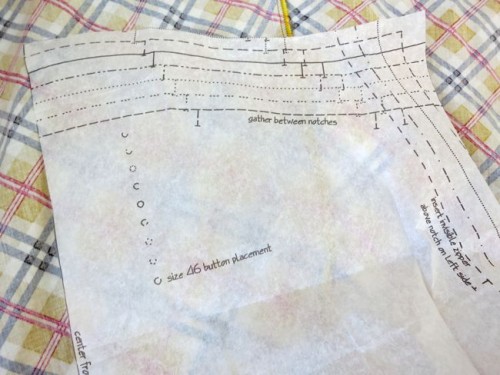 Seriously. Why couldn’t each dot be labelled with a size?
Seriously. Why couldn’t each dot be labelled with a size?
Then I actually got the dress sewn together and tried it on. I’d cut a size 36″ (I have a 37″ bust). It was too big. I took it in. I took it in some more. It ended up smaller than a size 34, and it’s still got more ease than I’d like in the bust. On the plus side, that means I managed skip the period-accurate lapped opening with domes and hooks that I was going to do: the frock just pulls on over my head.
Now, don’t get me wrong about the pattern. I found it frustrating and annoying, but on a different body type it would be quite flattering (rather than reasonably OK), and if historical accuracy isn’t your aim, the modern instead of historical instructions mostly won’t matter, and you might even prefer them (though lapped seams would make it easier, and I never did understand how they were telling me to put the sleeves together at the bottom 2cm).
My final alteration to the pattern was to skip the belt/sash detail. I’d already planned to turn the tie-belt into a flat buttoning sash (because really, all crisp and tailored in front and TWO bows in back makes no design sense, though it is period accurate). I made the belt up in both pink and white, and in both colours it just turned into two giant arrows pointing to “Stomach here!” and “Giant ribcage here!”. So I tried in plaid, and it just interrupted the pattern and looked stupid (even with a pink trim). So no belt.
For the photoshoot we went to the Sir Truby King gardens, which I don’t know how I’d never been to before. Brickwork! Arches! Cunning little winding stairs everywhere! I was in love! (and then I came home and read up on Sir Truby King, and was disturbed, and read some of his original writings, and was horrified. Plunket may be a wonderful organisation now, but it was founded on eugenics & ideas of race superiority and the premise that education for women should be avoided as educated women made bad mothers. SCARY!).
I wore the Shona of In the Heyday gift shoes, because I realised that while they have early 18th century potential, they also have definite 1930s vibes exactly as they are.

Also, how often do you get to wear white silk shoes with bows on the toe? Wearing them with the dress made it feel like a celebration, rather than “well, this is going to be an OK frock to wear when I just want to pull something loose over my head and feel reasonably polished” that it is going to be. When the ground was too rough I did take them off and skip around in little lace-up flats.
The Challenge: #26: Celebration
Fabric: 1.7m bias printed quilting/craft cotton ($4pm), 30cm poly chiffon ($1), raspberry linen (free)
Pattern: Decades of Style #3007 1930s button dress
Year: ca. 1935
Notions: 7 large raspberry pink buttons ($1.30 each), thread (stash), bias hem tape.
How historically accurate is it? The cut of the pattern is perfectly accurate, and I re-did the instructions to sew it in a period accurate manner, but my fabrics are completely inaccurate (ironically, the poly-chiffon is the only thing that might pass the ‘would a seamstress in period recognise this as a suitable fabric for this garment’ test), and after taking it in more than 2cm on each seam, I couldn’t do period accurate seam finishes like french seams (OK, I guess I could have pinked them or hand finished them) so I just overlocked the sucker. So 40% at best.
Hours to complete: 5
First worn: Sat Dec 14, for a Craft Crawl around the CBD with the girls from the Wellington Sewing Bloggers.
Total cost: $17.10 (and more than half of that was on buttons!)
And I’m done! (OK, actually, no, there are still a few things I want to finish!)
UPDATE: I’d like to add that despite my initial misgivings, I’ve ended up loving this dress, and I wore it as often as I could wash and dry it all summer. And I got tons of compliments every time I wore it.

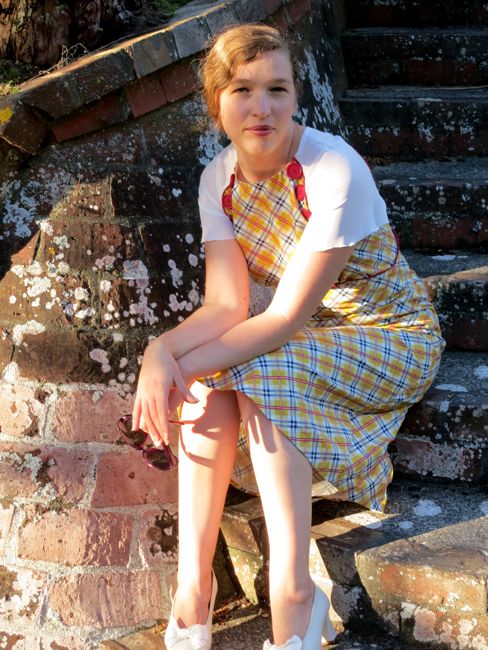

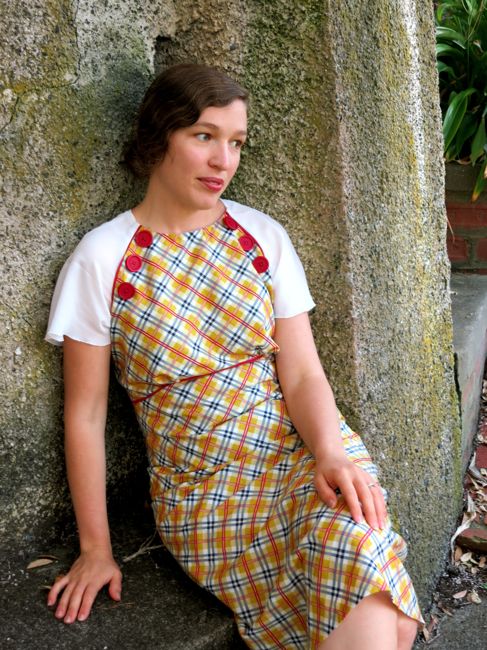
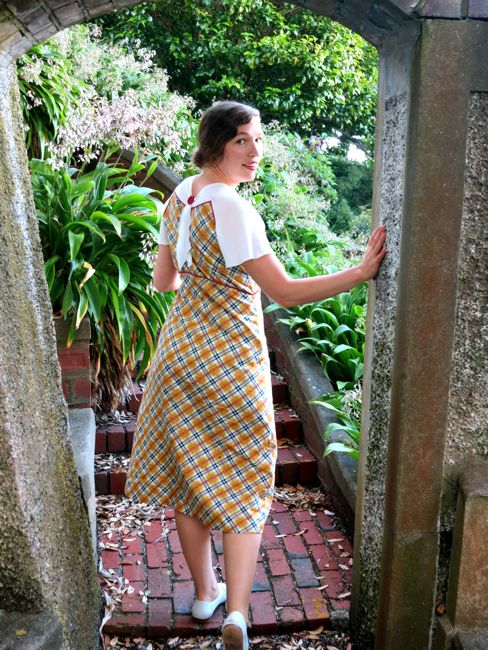

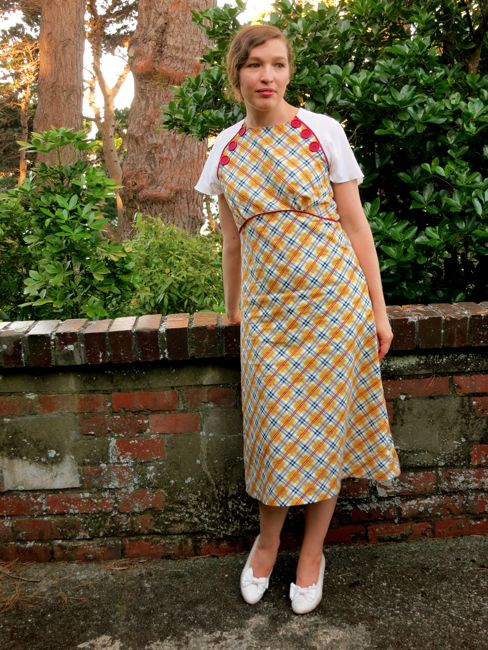
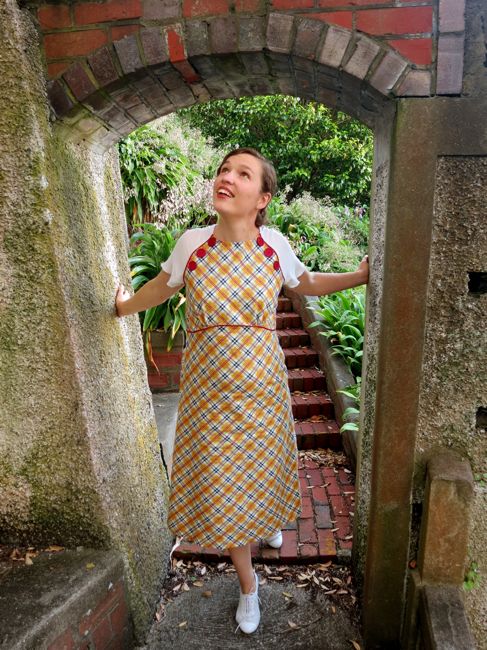
I really like the dress! I actually think it works really well and looks awesome.
Thanks Daniel! I do actually like it – I just don’t love it or feel as amazing in it as I do in other stuff I’ve sewn (and I keep tugging it down to keep it from forming swayback/full bottom wrinkles).
I made this dress too! My zipper work is terrible and it is on my list of redo projects. I think your dress looks great and I love the plaid.
And I keep meaning to mention, my parents just moved from Molokai. I enjoyed many relaxing days at mile marker 20.
Thanks Paige!
Other than the zip, how did your dress go? If you do replace the zip, can I make a recommendation? Either put in a lapped dome & hook opening, or put in a regular zipper with a lapped placket. Invisible zippers are too stiff to work successfully as side zips (drape an invisible zip and a regular zip over a finger and you’ll see what I mean).
Oh goodness, I’m sure my parents must know yours then! I can well visualise all the houses at mile 20 (the nice side of the island!) It’s a good place to spend time!
I think your button dress turned out splendid. It’s adorable! I had the same problems with my version, too — took it in at the side seams LOADS, and also raised the waistline up to more under the bust rather than midway down. It just made for sense with the gathering that one would expect to be just under the bust, and turned out more flattering too. Don’t disparage your dress too much, though. It’s really lovely. 🙂
Oooh…you made one too! I just looked it up and found it. Your first HSF entry – I remember now! It was gorgeous! And I’m glad to hear confirmation of the sizing issue – I wonder if it is only for the smaller sizes though?
Thank you on the dress! It is nice, and it is as I pictured it, but I don’t want to wear it every day, that’s all!
It’s very cute! And, honestly, I don’t think it looks like you have a huge ribcage. Skipping the belt and altering the tie in back were great decisions. I also completely agree that there are times when it’s easier to use the period technique. I learned that lesson the hard way, trying to set 18th century sleeves by machine.
Basically, my view on 1930s styles is that a lot of the time they’re just plain unflattering. When I look at ’30s photos, I see a whole lot of unflattering outfits. To get a ’30s pattern to look good and suit you, as this dress does, is quite an achievement and one that’s certainly worth celebrating. It’s a perfect entry for challenge #26.
Thanks Stella! I know – my ribcage is not really huge. Just a bit bigger proportionally.
Goodness! Setting 18th c sleeves with a sewing machine! Not fun.
The 30s is actually one of my favourite periods, and I think a lot of the styles are really flattering on me (and other shapes), but it can be tricky. But just look how good Loran makes 1930s look without having the standard twig-thin ’30s figure: http://loransworld.com/?p=1134
See! Totally flattering!
They really are flattering outfits. I need to revise my opinion of the ’30s!
Aren’t they fabulous! It really opened my eyes to the possibilities.
Ugh – modern instructions! I find they fail me far more than vintage ones. And you’re so right about lapped seams being much more practical for all the points and angled seams of the decade.
The non-piping is a cute idea too! I have a 30s pattern I won from Vintage4Me2 which has an option for the same kind of piping. Was thinking of making it up in some celery green linen I have – but what colour contrast!? Brown maybe?
Also not sure about the 30s day dress look suiting me either since Ive not sewn anything up like that before. You’re lucky you have the height at least to carry off those looks and also the hem length.
Such a shame that the pattern was so big overall. SO disappointing when that happens.
So…what are lapped seams? Please do tell!
In a ‘regular’ seam, you sew the fabric with the two right sides of the material facing each other. In a lapped seam, you take one piece of fabric – say the skirt piece, and you fold the selvedge to the back and press it in place. Then you lay the skirt piece over the bodice piece, and topstitch it down.
In a piece like the bodice joining to the joke, you could fold and press the bodice selvedges to make nice, crisp, square corners, and then you wouldn’t have to sew around a three-dimensional corner in the fabric, just a flat one where it layers over the yoke.
They are, needless to say, AMAZING!
Hope my explanation made sense!
Yep! I’m always wonderfully amazed by how clear and precise and easy to follow a ’30s pattern with 300 words of instructions is, compared to a modern one with 3,000!
I think you would look great in ’30s . I actually think it’s a hugely flattering decade for lots of shapes, but you do have a particularly classic ’30s shape!
I wouldn’t wear that design in a hundred million years (and my body type is similar to yours), but you make it look wonderful! I’m so glad it worked out for you.
It is pretty full-on isn’t it? I do like a strong pattern! Totally different styles are what make the world so wonderful though! And thank you!
I love this dress, I think it looks amazing on you and you simply must wear it to Napier next year, it’s just so, so quintessential! And it moves beautifully too.
I particularly love the drapey sleeve yokey thing with the back tie. So pretty. xo
Awww <3 Thank you! I really appreciate your opinion as you've actually properly seen it in person.
I am warming up to it a LOT - it makes a good pull-on-and-look-put-together look. I might have to change clothes 4 times a day in Napier 😉
I don’t know why you think the shape doesn’t flatter you. You look great wearing it. Like you walked out of the era.
Thanks Lady D! That’s pretty much the ultimate compliment you can give a vintage seamstress!
You’ve done an excellent job at this and it looks great! Well done persevering with a frustrating project. The shoes look awesome! Off to read that blog post…
Thanks Shona. I am LOVING the shoes. They really make the dress special, and it turns out they go fabulously with some other periods too! Thank you so much for thinking of me when you saw them!
I think the dress looks lovely on you, and the combination of plaid fabric, white chiffon, piping and buttons is great!
This post has made me feel tons better.
1) Because I’m grappling with Vogue 8686 at present, and it’s winning hands down. It’s a 1930s Vintage Vogue pattern, and it does used lapped seams and a lapped dome & hook opening, but the first attempt was massively too big on me. I took it in, and now I need to take it in some more. Grrr.
2) Because now I know I’m not the only person who reads instructions end-to-end before I start. Yay!
I’m intrigued by non-piped piping. How do you get it an even width as you sew, without the cord to sew against?
Woohoo! Pattern geek twins! I’m sure I got it from my dad – he reads camera and computer manuals end to end.!
And thank you! I did think the fabric and notions were pretty inspired. I had to SEARCH for those buttons – they don’t make many in raspberry pink. Lots in very pinky-pinks, and lots in red.
I’m impressed that Vogue 8686 has proper vintage techniques! Sounds like they added modern ease in though. I generally recommend that people sew 4 sizes down from the recommended one in modern Vogues (i.e. Vogue says I should sew an 18 – I sew a 12, and occasionally a 10, and have never had them be too small in those sizes!)
You sew silent piping VERY CAREFULLY, with a very steady hand, after cutting it VERY PRECISELY. 😉 And the first 37 times you do it you unpick all over the place in little bits and make tiny adjustments and re-sew, before you finally master the technique (‘mastering the technique’ includes deciding no-one will notice if it is a millimeter off!) 😛
It also helps if you have a slightly translucent fabric as one sandwich side, so you can see through to your edge to use as a guide. 😀
Thank you so much, both for the explanation of silent piping and the tip about Vogue patterns! That would explain why my previous Vintage Vogue attempt, 2787, also turned out way too baggy.
Agreed–completely!–about patterns using vintage technique when it makes more sense. Especially as, for me, sewing vintage patterns and learning the techniques they demand is how I stretch myself as a seamstress. I love picking up a pattern and realizing I’ll need to do something new!
I’m really surprised a vintage reprint company did this, to be honest–I’ve found vintage technique in mainstream reprint patterns (like Vintage Vogue)! In fact, it was a modern reprint Vogue pattern where I first learned the loveliness of lapped seams.
And maybe the fabric could be drapey-er, but goodness! That plaid is too, too cute. You look adorable. Worth it 🙂
I was really surprised too – I did notice the fact that they called for a size-invisible zip (which is a stupid idea as invisible zips don’t bend enough for successful side-zip placement), but didn’t expect the instructions to be completely modern.
Isn’t the plaid just darling? I couldn’t pass it up for the dress, even if it was ‘wrong’! And thank you! 😀
I love how it looks on you, and you make me want to try making it! (Which is a bad idea, I never finish anything I start on the machine …) Some of your body features I share, but since I think it actually does look good on you, maybe that’s a good omen for me!
Totally agree about the modern/vintage(/historical) methods issues – it’s just so much easier to do it the way that the pieces were intended to be put together.
Thanks Cassidy! Maybe this could be your first successful machine project? 😉
I agree that it does look good on me (trying not to be too much of a Whinging Winfred), I just don’t feel quite as pretty in it as I’ve felt in other frocks.
The period sewing method thing holds true for lots of periods – I often find myself explaining why it actually is easier to make an 18th century dress by hand!
Hi Leomomi,
Obviously this comment on your post is coming very late in the game but better late than never. First of all, your dress is really really pretty! (the plaid colors are unusual but we like them) The fabric blocking, piping and buttons all complement each other to perfection. In spite of all the trouble you had during construction, your result is wonderful. We LOVE your photos – so much better than what we have on our website! To our eyes, the dress is not the unflattering style you find it to be.
We are really sad to hear you had such an unpleasant time using our pattern. You might not believe it but we work very hard to make these patterns as accessible as they can be for most people.
We know the pattern can be hard to read with so many sizes stacked up. When we did patterns in size groups of 3 sizes per pattern, it cut down on the confusion with the reference marks but we got feedback that customers wanted more sizes in the patterns. It is a difficult trade off. We did try labeling all the sizes for the reference marks and to our eye, it made the pattern look cluttered. We thought it was better to just label the extreme size since there were so many lines, etc. already on the pattern. It sounds like we got that decision wrong.
You have a good point regarding the zipper. The original dress called for a side placket opening with snaps. This treatment would result in a lovely, drape-y finish at the side but the most people sewing today are completely unfamiliar with that construction. Like with the separate size groups, we first tried keeping the original vintage sewing techniques in the instructions. Again, we got feedback asking for modern, familiar and quick construction techniques (ie — not much hand sewing). We agree that vintage sewing techniques often work better, we just found that people wanted something modern.
It is a struggle to bridge the gap between modern and vintage demands. We really appreciate your thoughtful and detailed post and feedback. We’ll keep working at it and hopefully this experience has not put you off our patterns forever 🙂
Thanks Janet – I’m happy to hear responses whenever they come, and am honoured that you checked in and liked my dress so much.
I’m certain that you work very hard to make your patterns as good as possible, for as many types as sewers as possible, and I definitely understand that this is a very tricky balance!
I hope that my post/review made it clear that original period techniques and instructions is my personal preference, but obviously, this isn’t going to be what everyone wants, so it’s understandable why you updated them. I guess the ideal situation would be to have both, but obviously that is a huge amount of work for you, and probably not economically viable. I do think there are some places where original techniques (like lapped seams) are really the only way to get a really good finish, and should be kept.
I could definitely see places on the pattern where numbering all the sizes would be really cluttered, but there were spots (as with the button placement) where more size numbering would be both helpful and still well spaced and easy to see.
I probably won’t be making this pattern again, as I’ve managed to find an original 1930s pattern with a very similar cut, which let’s me have the period techniques I want and the look of your pattern, but I’ll certainly be trying other Decades of Style patterns.
We’re really glad to hear you’d be willing to try another Decades pattern someday! If you haven’t looked at our site in a while — you might want to visit it because we just updated the design 2 weeks ago and added photos for a few more patterns. And we just started an Instagram account under the name decades_of_style . If you are interested in seeing some snaps of more samples, etc., you can follow us there.
We appreciate what a time consuming endeavor a blog post is! And this after the time spent making the dress!! We’re happy that you chose our pattern and took the time to blog about it. We’ll definitely keep your comments and suggestions in mind in the future regarding labeling and sewing techniques. We really appreciate how clear and thoughtful your writing is. We did understand you were talking about your personal preferences regarding sewing technique; we just wanted to let you know how we came to put out the product like it is. You are so right about it being hard to find the right balance to appeal to as broad a market as possible! We love what we do so we’ll just keep working on it and hopefully improve with each pattern!
You really should love this dress, it is very becoming on you. Sometimes it is hard to understand what is becoming so it is great to try new models ones in a while.
I love this dress! The non-flattering shape etc is so authentic! And I don’t think it is actually that non flattering because you made it to fit you and fitting clothes are always more flattering than ill fitting ones.
Anyway this is the kind of look I’m searching for (not to make myself because I can’t) for a twenties-thirties working class gig I’m going to. And it’s surprising how few ugly-fabric dresses there are out there. Well done for creating this great dress and I love the drapy ribbon at the back, actually v sexy in a 30s way. -Sef